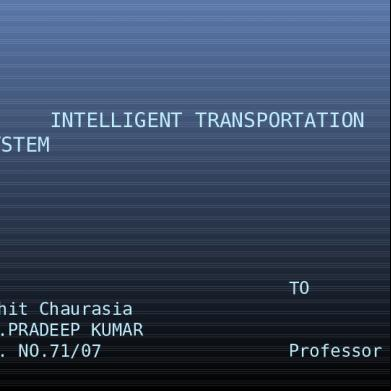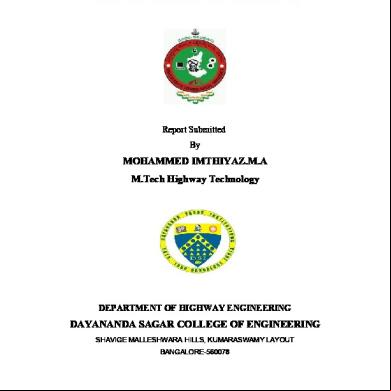Intelligent Transportation System 4p2263
This document was ed by and they confirmed that they have the permission to share it. If you are author or own the copyright of this book, please report to us by using this report form. Report l4457
Overview 6h3y3j
& View Intelligent Transportation System as PDF for free.
More details h6z72
- Words: 539
- Pages: 33
INTELLIGENT TRANSPORTATION SYSTEM
BY Rohit Chaurasia Dr.PRADEEP KUMAR SR. NO.71/07
TO Professor
INTELLIGENT TRANSPORTATION SYSTEMS
Learning Objectives Definition of ITS Importance with respect to the future
of transportation Projected ITS infrastructure benefits Major ITS areas Required skills
What are Intelligent Transportation Systems (ITS) ? The application of high technology and computer power to current freeway, traffic, and transit systems to increase the safety and efficiency of the surface transportation system. Have the potential to solve future problems.
ITS is...
...Traffic and Transit Management
ITS is...
...Traffic Signal Systems
ITS is...
...Global Positioning Systems
ITS is... Weather
Information Systems
Commercial
Vehicle Electronic Clearance
ITS is...
...Real-Time Traveler Information
Why is ITS Important? Offers the next major leap forward in
improving safety, convenience, and productivity of our personal and commercial travel. Critical as population and congestion increase, and land and funding for new roads decrease.
What are We Doing Differently? Improving productivity through
advanced technology and management techniques Operating existing programs more efficiently Integrating systems Providing travel information
Projected ITS Infrastructure Benefits (1996-2015) Accident Cost Savings (44%) Time Savings (41%) Emissions/Fuel (6%) Operating Cost Savings (5%) Agency Cost Savings (4%) Other (< 1%) Source : Apogee Report on Global ITS Benefits
What’s it Worth? Identified Benefits Time Savings Improved Throughput Reduced Crashes and Fatalities Cost Avoidance Increased Customer Satisfaction Energy and Environmental
Benefits
Major ITS Areas Multimodal Travel Management and
Traveler Information Advanced Traffic Management Systems Advanced Traveler Information Systems Advanced Public Transportation Systems Advanced Rural Transportation Systems
Commercial Vehicle Operations Advanced Vehicle Control and Safety
Systems
Multimodal Travel Management and Traveler Information Multimodal Regional Traveler Information
Transit Management
Incident Management
Freeway Management
Electronic Toll Collection
Emergency Management
Electronic Fare Payment
Highway Rail Intersection Safety
Traffic Signal Control
Multimodal Regional Traveler Information
Freeway Management
Traffic Signal Control
Transit Management
Electronic Toll Collection
Electronic Fare Payment
Incident Management
Emergency Management
Highway Rail Intersection Safety
Commercial Vehicle Operations
Commercial Vehicle Operations
Achieve safe, simple, and cost-
effective commercial vehicle operation through cooperation and advanced technologies
Commercial Vehicle Operations Benefits Improved safety monitoring Paper work reduction Revenue collection improvement Stop only high-risk
drivers/carriers/vehicles Simplify/speed up/reduce roadside inspections Tax payments, licenses, and permits
Commercial Vehicle Operations Benefits Rover Vans Perform safety inspections anywhere Portable computers simplify inspections
In-vehicle systems: Equipment malfunction warning systems
Other: Electronic toll collection keeps vehicles
moving Cost-effectiveness
Collision Avoidance Program
Intelligent Vehicle Initiative
Merging of all vehicle-focused ITS
activities Emphasizes the significant role of the driver in highway safety Develop and made available driving assistance and control intervention systems Applications for all types of vehicles on all types of highways
ITS Opportunities: Required Skills Engineering Electronics Communications Systems Integration
CONCLUSIONS APTS technology along with fleet management systems can make us to achieve sustainable and environmental friendly transportation for the 21 st century. ITS has been proved to be optimal solution to the enigma of building and operating transportation to meet growing urban travel demand in developed countries.
THANK YOU
BY Rohit Chaurasia Dr.PRADEEP KUMAR SR. NO.71/07
TO Professor
INTELLIGENT TRANSPORTATION SYSTEMS
Learning Objectives Definition of ITS Importance with respect to the future
of transportation Projected ITS infrastructure benefits Major ITS areas Required skills
What are Intelligent Transportation Systems (ITS) ? The application of high technology and computer power to current freeway, traffic, and transit systems to increase the safety and efficiency of the surface transportation system. Have the potential to solve future problems.
ITS is...
...Traffic and Transit Management
ITS is...
...Traffic Signal Systems
ITS is...
...Global Positioning Systems
ITS is... Weather
Information Systems
Commercial
Vehicle Electronic Clearance
ITS is...
...Real-Time Traveler Information
Why is ITS Important? Offers the next major leap forward in
improving safety, convenience, and productivity of our personal and commercial travel. Critical as population and congestion increase, and land and funding for new roads decrease.
What are We Doing Differently? Improving productivity through
advanced technology and management techniques Operating existing programs more efficiently Integrating systems Providing travel information
Projected ITS Infrastructure Benefits (1996-2015) Accident Cost Savings (44%) Time Savings (41%) Emissions/Fuel (6%) Operating Cost Savings (5%) Agency Cost Savings (4%) Other (< 1%) Source : Apogee Report on Global ITS Benefits
What’s it Worth? Identified Benefits Time Savings Improved Throughput Reduced Crashes and Fatalities Cost Avoidance Increased Customer Satisfaction Energy and Environmental
Benefits
Major ITS Areas Multimodal Travel Management and
Traveler Information Advanced Traffic Management Systems Advanced Traveler Information Systems Advanced Public Transportation Systems Advanced Rural Transportation Systems
Commercial Vehicle Operations Advanced Vehicle Control and Safety
Systems
Multimodal Travel Management and Traveler Information Multimodal Regional Traveler Information
Transit Management
Incident Management
Freeway Management
Electronic Toll Collection
Emergency Management
Electronic Fare Payment
Highway Rail Intersection Safety
Traffic Signal Control
Multimodal Regional Traveler Information
Freeway Management
Traffic Signal Control
Transit Management
Electronic Toll Collection
Electronic Fare Payment
Incident Management
Emergency Management
Highway Rail Intersection Safety
Commercial Vehicle Operations
Commercial Vehicle Operations
Achieve safe, simple, and cost-
effective commercial vehicle operation through cooperation and advanced technologies
Commercial Vehicle Operations Benefits Improved safety monitoring Paper work reduction Revenue collection improvement Stop only high-risk
drivers/carriers/vehicles Simplify/speed up/reduce roadside inspections Tax payments, licenses, and permits
Commercial Vehicle Operations Benefits Rover Vans Perform safety inspections anywhere Portable computers simplify inspections
In-vehicle systems: Equipment malfunction warning systems
Other: Electronic toll collection keeps vehicles
moving Cost-effectiveness
Collision Avoidance Program
Intelligent Vehicle Initiative
Merging of all vehicle-focused ITS
activities Emphasizes the significant role of the driver in highway safety Develop and made available driving assistance and control intervention systems Applications for all types of vehicles on all types of highways
ITS Opportunities: Required Skills Engineering Electronics Communications Systems Integration
CONCLUSIONS APTS technology along with fleet management systems can make us to achieve sustainable and environmental friendly transportation for the 21 st century. ITS has been proved to be optimal solution to the enigma of building and operating transportation to meet growing urban travel demand in developed countries.
THANK YOU










